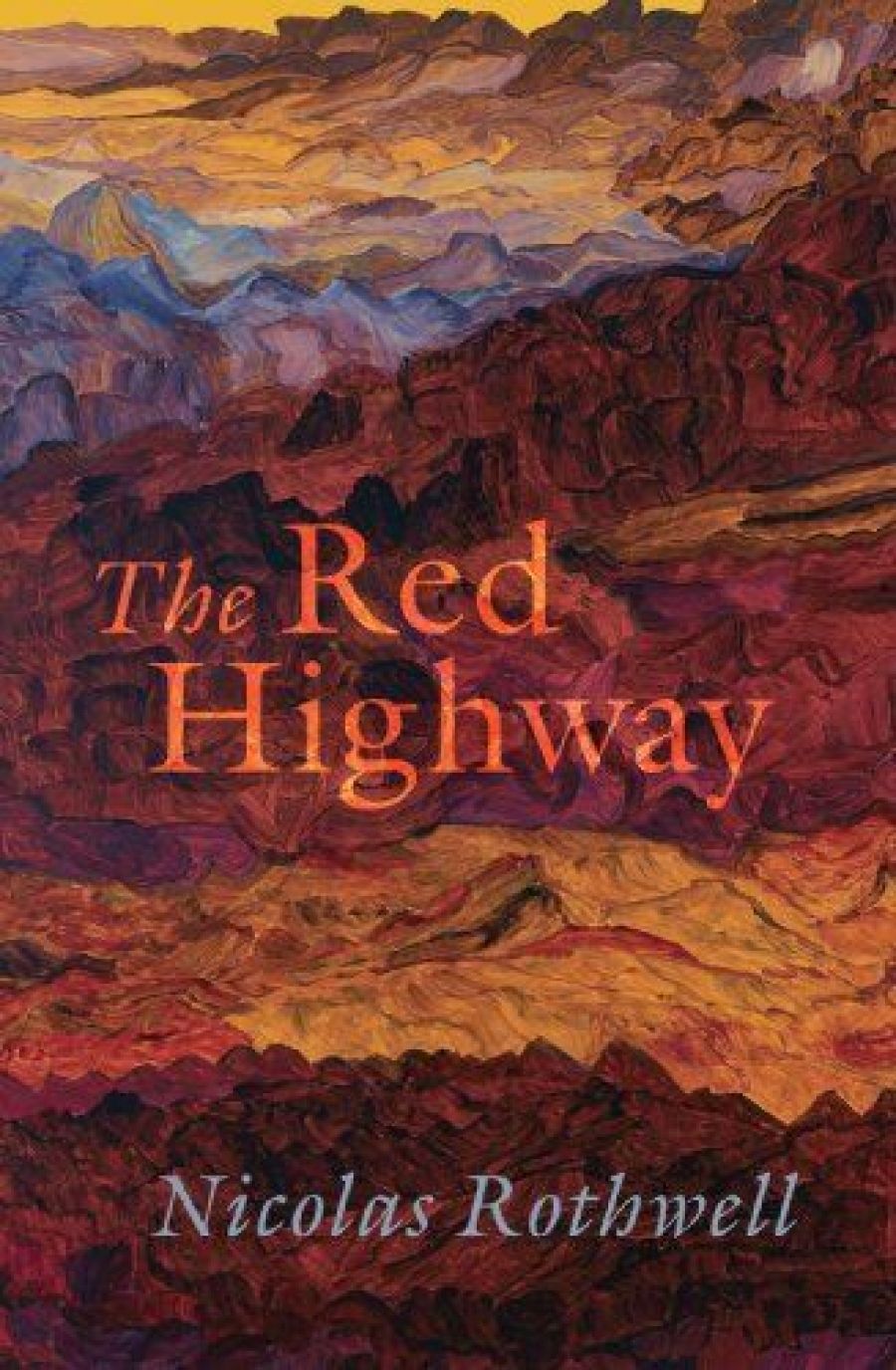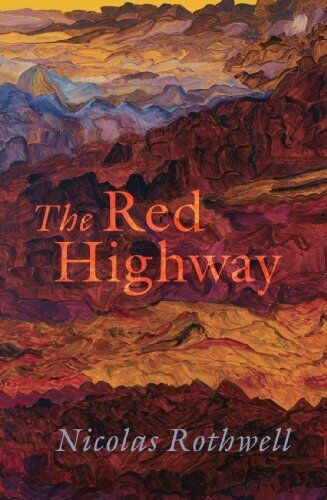
- Free Article: No
- Contents Category: Travel
- Review Article: Yes
- Article Title: Whitmanesque journeyer
- Online Only: No
- Custom Highlight Text:
Towards the close of the second section of The Red Highway, Nicolas Rothwell is driving across the Kimberley Plateau towards Wyndham with a hitchhiker, an Aboriginal girl. When she asks why he has come back, he tells her that while he was a reporter in the Middle East he heard stories about places in the Kimberley that reminded him of people he knew there and of how much he missed the country. He tells her that ‘people who come to northern Australia come here because they’re lost, or searching, or on the edge of life, and silence, and they’re chasing after some kind of pattern, some redemption they think might be lurking, on the line of the horizon, out in the faint, receding perspectives of the bush’. He turns on the radio and picks up a station based in Kununurra. The announcer is chatting about strongyloids, a parasitic worm which causes heart and kidney problems in outback communities. ‘“I’ve got that,” said Cherandra proudly.’
- Book 1 Title: The Red Highway
- Book 1 Biblio: Black Inc., $32.95 pb, 266 pp
- Book 1 Cover Small (400 x 600):

There’s not a lot of this kind of juxtaposition in The Red Highway, but the scene stays with the reader because we become somewhat uncomfortably privy to what drives Rothwell, although he makes feints in its direction many times. He breaks the spell fast, the girl slips out at the Port Hotel and he walks into the historical society to find a man who remembers him from years ago.
When Rothwell first returned to Darwin (‘a place where everyone seems to trail the ill-concealed shadow of their personal narrative’), he had been reading Karel Kupka’s Dawn of Art (The Red Highway opens with his radiant essay on Kupka, which was included in The Best Australian Essays 2008). Kupka had drawn attention to the similarities between bark paintings and the design of shells. Now Rothwell meets a scientist who knows all there is to know about molluscs and understands this comparison. ‘Shells can take you too far into yourself. You need to make sure they lead you back, in the end, to other people,’ the scientist warns him.
The four sections of The Red Highway coalesce into something one might clumsily describe as a cantata for the north-west and the centre, places and stretches of country of which most of us will never have any real knowledge. Rothwell, at his best, which is most of the time, seems to be more composer than writer; more master of song than sentence. He handles grammatical tense so well that you don’t notice it, and many of the stories he tells – stories already told in books and records that he has read, and which become a seamless part of his travels – lose their exact chronological place and seem to take shape as the landscape or its light changes. The histories of remarkable anthropologists and explorers, naturalists and eccentrics slide into his landscapes so that their experiences become a part of what he sees.
I read ‘Visions’, the third section of the book, late at night, unable to sleep while staying in a dank motel in Brunswick Heads, near the easternmost tip of the continent. A monsoonal storm pushed angrily through the pines on the bank of the river. I began to read and couldn’t stop. Rothwell is in Alice Springs. He tells the story of the Dutch painter Henk Guth, who painted a panorama of the country around Alice in the 1970s. The first time he had seen it, Guth himself came in and spoke to him. It is this kind of happenstance which is central to the structure of Rothwell’s storytelling. Guth, whose grave is close to Ormiston Gorge, leads him to remember the Warburtons, father and son. The Warburtons take him to the ‘desert oaks and bloodwoods, the abrupt hills which rise like island archipelagos in a red sea of sand dunes and loom on the horizon, mauve from distance’. Rothwell had taken one book with him to the Middle East, the naturalist H. H. Finlayson’s The Red Centre, published in 1935. He reads Finlayson’s book ‘in the back rooms of small hotels in the Syrian desert’, just as I read his in the decrepit, storm-tossed motel, entranced by Rothwell’s descriptions of Finlayson’s journeys. Rothwell was so caught up in the Finlayson story that he was surprised by a fierce storm front over the MacDonnell Ranges, which seemed to rise out of Finlayson’s ‘overwrought and troubled pages’. I am open to all connections now, under some kind of storytelling hypnosis.
Then more stories and elliptical quests in this country where old friends ask why he is here. ‘Somewhere to come back to,’ he answers, ‘Unwritten country.’ One friend says he gave up on words years ago. Rothwell doesn’t give up on words. They pour from him and become a literary voice which offers page-turning mythologies that just might be half-truths. He travels with another old friend, the ‘Linnaeus of Central Australia’, Peter Latz, who suggests that Rothwell – romantic, dreamer, idealist – is travelling in this country in order to find out how to die. And Rothwell calls Finlayson overwrought!
He sets out for Mantamaru and Ngaanyatjarra lands. Near Mount Connor (I have the atlas open; it gets me nowhere), he stops at a roadhouse and meets another desert philosopher who tells him about a trip into the Gibson desert. He found that he ‘understood what the real deserts are: us: our death and taint’. ‘“Any revelations?” an old acquaintance asks about this last conversation. “One or two.” “Believable ones?” “Of course – and maybe even true.”’
In the last of the four sections, ‘Return’, Rothwell tells another mesmerising story: that of Albert Calvert, who made expeditions through the north-west and to the Pilbara around the close of the nineteenth century. Calvert was, according to Rothwell, a speculator and investor, a share trader and a company floater, a philatelist and racehorse trainer, an artist and a newspaper proprietor, a publicist and an obsessive author. Calvert viewed himself as ‘a traveller, a narrator, a watcher with a creative sensibility’, writes Rothwell, who might just as well have been describing himself, except for the distinction of his melancholy. Calvert financed a scientific expedition in the 1890s. Its goal was to map the Great Sandy Desert between the Murchison and Fitzroy rivers, and its leader was Lawrence Wells, who now provides Rothwell with his penultimate transfixing story.
The Red Highway begins in the Middle East. In Jerusalem, Rothwell has met a priest who worked, improbably, at a mission in Kalumburra in the Kimberley; and later a nun in a White Russian monastery who shows him, more improbably, a painting by Daisy Andrews, a Walmajarri woman from Fitzroy Crossing. Rothwell relates to Sister Sophia Daisy’s story and plans to tell Daisy, on his return, about the painting in the monastery. He leaves the Middle East with a strong sense of dust and fragmentation. The Red Highway, a ‘sandy, dusty realm’, is for him a landscape which has an ‘interwoven, interconnected quality: a musical aspect –a repetition, and variation: the way the light filtering through the stringy-barks echoes, and speaks to the changes in the landforms; the way shape and pattern are multiplied at different levels, so that the branching arms of a river delta seem like the veins of a leaf ...’ (from a speech given at the ABC’s North Australia Forum and published in The Monthly, in July 2008).
Rothwell is a caster of spells, his writing often incantatory and Whitmanesque. Sometimes, instead of willingly being swept into his Pastorals, his Appassionatas, his Requiems, his Turangalîla, I baulked at the sense of competition which creeps into the conversations with some of his friends of the outback, something which is a little too exclusive and self-congratulatory, but always I am swept back into the music, give myself up to it, and am grateful.


Comments powered by CComment